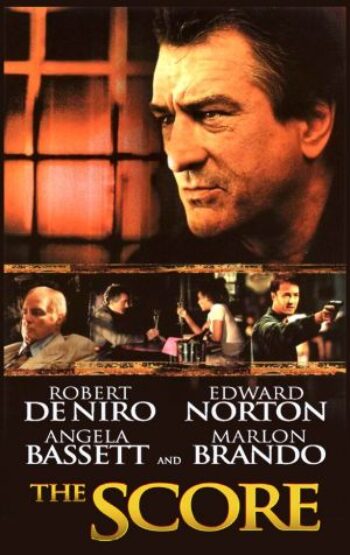
07.09.01
THE SCORE
Three generations of method acting giants unite for this crime thriller written by Kario Salem and directed by Frank Oz. Robert De Niro stars as Nick Wells, an aging thief whose specialty is safecracking and who is on the verge of retiring to a life of ease, running his jazz club and romancing his girlfriend Diane (Angela Bassett). But before he can ride off into the sunset, Nick is pressured to do one last job by his mentor and business partner, a flamboyant and extravagant upscale fence named Max (Marlon Brando). Max is plotting the heist of the Montreal Customs House, and he’s got a man on the inside, Jackie Teller (Edward Norton), a talented but volatile crook who has managed to ingratiate himself with the facility’s staff as a fellow employee suffering from cerebral palsy. Jackie bristles at Nick’s interference in “his” score, however, and threatens violence when it seems he’s going to be cut out of the action. In the meantime, Nick grows increasingly ill at ease about the operation, as it violates his two most important dictums in thievery: always work alone and never pull a job in your own city. The part of Max in The Score was written specifically for Brando by screenwriter Salem, although the improvisational star and his director Oz reportedly clashed during filming. ~ Karl Williams, Rovi
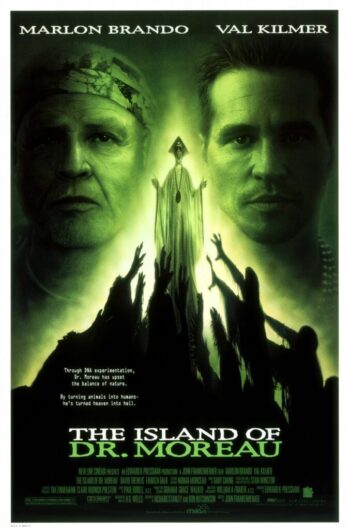
08.23.96
THE ISLAND OF DR. MOREAU
On a remote tropical island, Dr. Moreau has appointed himself ruler over a menagerie of genetic mutants fashioned in his gene-splicing chamber of horrors. The products of his misguided attempt to create a more “pure” human species, the man-beasts worship Moreau as their god and “father” and live by his code of law — a code rigidly enforced by radio-operated implants in their bodies capable of inflicting pain and death. Into this surreal nightmare arrives UN negotiator Edward Douglas (David Thewlis), the sole survivor of an airplane crash. Douglas is brought ashore on Moreau’s island — against his better judgment — by the doctor’s insane, drug-addled assistant, Montgomery (Val Kilmer), and eventually becomes a prisoner. Horrified by the doctor’s monstrous experiments and afraid for his own life, Douglas seeks the aid of Moreau’s lovely daughter, Aissa (Fairuza Balk), in escaping the island, but is foiled at every turn by Montgomery and his armed man-beast lackeys. Eventually, the creatures discover the existence of their electronic implants and remove them, providing the opportunity for an armed rebellion — but eventual regression into their original animal state causes their revolt to collapse into anarchy. ~ Cavett Binion, Rovi
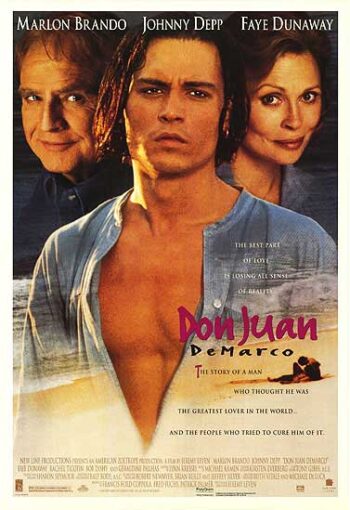
04.07.95
DON JUAN DEMARCO
A psychiatrist treats a most unusual patient, only to find that the doctor is the one who gains the most from their sessions in this philosophical romantic comedy. A young man in a mask and cape (played by Johnny Depp) is standing atop a billboard, threatening to jump. When the potential suicide is finally talked down, he’s brought to a psychiatric facility where after one doctor washes his hands of the case, he’s placed under the supervision of Dr. Jack Mickler (Marlon Brando), an aging psychiatrist soon to retire. The patient informs Mickler that he is actually the great lover Don Juan, who has seduced over 1,500 women, but has fallen into a deep depression after being unable to win the hand of the woman of his dreams. Mickler has ten days to work with “Don Juan,” after which he will either be released on medication or committed to a long-term stay in a mental hospital. As Mickler talks with the young man, who speaks rapturously of the art of love, the doctor finds that his philosophies are helping to kick start his failing relationship with his wife (Faye Dunaway), and he slowly becomes convinced that his patient might really be Don Juan after all. Don Juan DeMarco’s theme song, “Have You Ever Really Loved a Woman,” became a major hit for singer and songwriter Bryan Adams; after working with Marlon Brando on this film, Johnny Depp cast the legendary actor in a key supporting role in his directorial debut, The Brave. ~ Mark Deming, Rovi
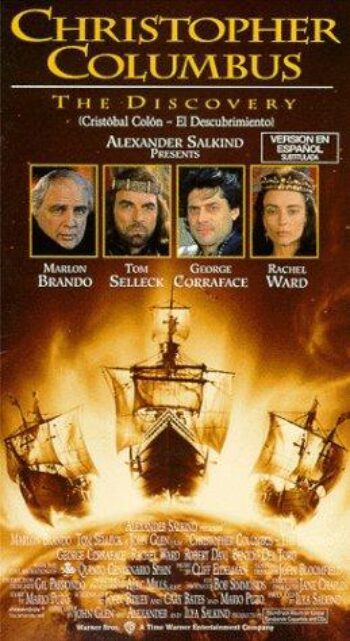
08.21.92
CHRISTOPHER COLUMBUS: THE DISCOVERY
John Glen directed this throwback to the costume dramas of the 1930s and 1940s, but without a smidgen of their energy and verve. George Corraface plays Christopher Columbus as a dynamic and muscular comic-book hero. He has a dream to set sail to find a new passageway to India, but he needs the backing of the Spanish government to do it. First, he must undergo a grilling by Tomas de Torquemada (Marlon Brando in, hands down, his worst performance). After passing muster with Torquemada, he gets the blessing of Queen Isabella (Rachel Ward) and King Ferdinand (Tom Selleck). Columbus then sets sail in a series of picture-postcard travelogue shots as he sails the ocean blue and discovers a new world of wonders — particularly the Indian chief’s well-endowed daughter. As a sop to revisionists, a rat is seen scampering down the plank as Columbus’ vessel lands on “undiscovered” turf. ~ Paul Brenner, Rovi
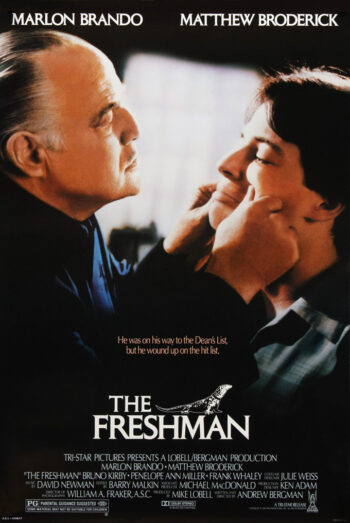
07.20.90
THE FRESHMAN
In this farcical comedy, Matthew Broderick plays Clark Kellogg, an aspiring director who arrives in New York City to attend film school. However, moments after he arrives in the city, he’s robbed by Victor Ray (Bruno Kirby), leaving him no money for the $700 in books required by his instructor, Arthur Fleeber (Paul Benedict). A few days later, Clark runs into Victor and demands his money back, but Victor has already lost it (on a horse race in which he wasn’t entirely sure the animal he bet on was a horse). Instead, he offers to fix Clark up with a job with his boss, an “importer and exporter” named Carmone Sabatini (Marlon Brando), who bears a stunning resemblance to Don Corleone in The Godfather. Clark’s adventures with Sabatini are just beginning when he’s instructed to pick up a package from the airport. Clark is expecting it to be contraband, and he’s right, but not in the way he figured — it turns out he’s accepting delivery of a komodo dragon, which is to be served at a “gourmet club” specializing in dishes prepared from endangered species. Marlon Brando’s hilarious comic variation on one of his best-known roles is the highlight of this film, but Bruno Kirby and Paul Benedict also deliver fine comic turns, and Matthew Broderick copes nobly with his role as the film’s lone normal person. ~ Mark Deming, Rovi
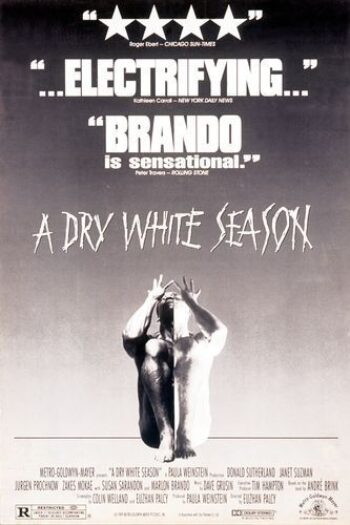
09.10.89
A DRY WHITE SEASON
Schoolteacher Ben du Toit (Donald Sutherland) has been insulated all his life from the horrors of apartheid in his native South Africa. Perhaps he really didn’t want to know. When the son of his black gardener is arrested and beaten as a result of a schoolboy protest in Soweto, at first he imagines the police must have had their reasons. However, the boy is picked up again, and this time he doesn’t come back. Ben promises his servant that he will look into the incident, and discovers that the boy was killed simply to gratify the violent urges of Captain Stolz (Jurgen Prochnow), a “special branch” policeman. At long last he has gotten a glimpse into the truly arbitrary and violent nature of the system he has so long benefitted from, and he hires Ian Mackenzie (Marlon Brando) to prosecute the killer. It is a foregone conclusion that Stolz will not be punished, but Mackenzie rises to new heights of withering sarcasm and irony in the courtroom. This situation turns Ben into a radical firebrand, which alienates him from his white friends and neighbors, as well as members of his family. ~ Clarke Fountain, Rovi
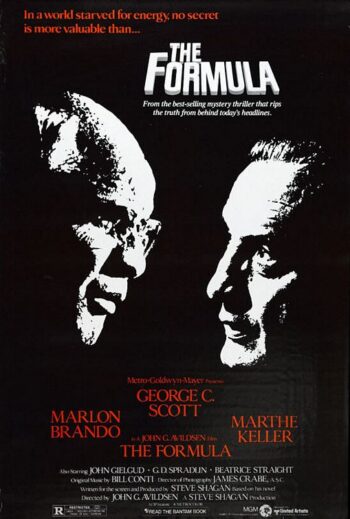
12.19.80
THE FORMULA
With George C. Scott and Marlon Brando heading the cast, The Formula should have been far better than it is. Adapted by Steve Shagan from his own best-selling novel, the film is predicated on the concept that a formula for synthetic fuel had been developed by the Nazis during WW II. In the intervening 35 years since the war’s end, the formula has disappeared and several people connected with it have died under mysterious circumstances. Also during this period, oil magnate Adam Steiffel (Marlon Brando) had commiserated with one of the decedents. Police officer Barney Caine (George C. Scott), a friend of the dead man, hopes to solve the mystery, and in so doing gets mixed up in a wide-ranging conspiracy to manipulate worldwide fuel prices. Reportedly, The Formula underwent a great deal of editing-room surgery before its release. If so, the editors certainly erred in retaining so many of the film’s interminable “steadicam” sequences. ~ Hal Erickson, Rovi

08.15.79
APOCALYPSE NOW
One of a cluster of late-1970s films about the Vietnam War, Francis Ford Coppola’s Apocalypse Now adapts the Joseph Conrad novella Heart of Darkness to depict the war as a descent into primal madness. Capt. Willard (Martin Sheen), already on the edge, is assigned to find and deal with AWOL Col. Kurtz (Marlon Brando), rumored to have set himself up in the Cambodian jungle as a local, lethal godhead. Along the way Willard encounters napalm and Wagner fan Col. Kilgore (Robert Duvall), draftees who prefer to surf and do drugs, a USO Playboy Bunny show turned into a riot by the raucous soldiers, and a jumpy photographer (Dennis Hopper) telling wild, reverent tales about Kurtz. By the time Willard sees the heads mounted on stakes near Kurtz’s compound, he knows Kurtz has gone over the deep end, but it is uncertain whether Willard himself now agrees with Kurtz’s insane dictum to “Drop the Bomb. Exterminate them all.” Coppola himself was not certain either, and he tried several different endings between the film’s early rough-cut screenings for the press, the Palme d’Or-winning “work-in-progress” shown at Cannes, and the final 35 mm U.S. release (also the ending on the video cassette). The chaotic production also experienced shut-downs when a typhoon destroyed the set and star Sheen suffered a heart attack; the budget ballooned and Coppola covered the overages himself. These production headaches, which Coppola characterized as being like the Vietnam War itself, have been superbly captured in the documentary, Hearts of Darkness: A Filmmaker’s Apocalypse. Despite the studio’s fears and mixed reviews of the film’s ending, Apocalypse Now became a substantial hit and was nominated for eight Academy Awards, including Best Picture, Best Director, Best Supporting Actor for Duvall’s psychotic Kilgore, and Best Screenplay. It won Oscars for sound and for Vittorio Storaro’s cinematography. This hallucinatory, Wagnerian project has produced admirers and detractors of equal ardor; it resembles no other film ever made, and its nightmarish aura and polarized reception aptly reflect the tensions and confusions of the Vietnam era. ~ Lucia Bozzola, Rovi
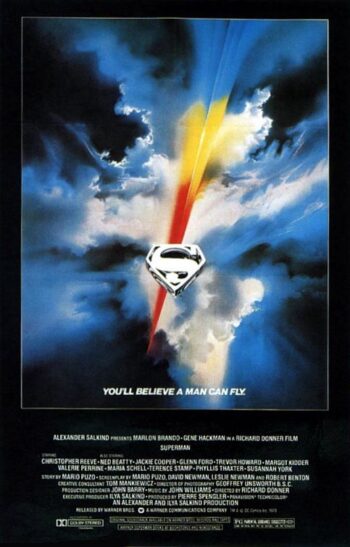
12.10.78
SUPERMAN
Richard Donner’s big-budget blockbuster Superman: The Movie is an immensely entertaining recounting of the origin of the famous comic book character. Opening on Krypton (where Marlon Brando plays Superman’s father), the film follows the Man of Steel (Christopher Reeve) as he’s sent to Earth where he develops his alter-ego Clark Kent and is raised by a Midwestern family. In no time, the movie has run through his teenage years, and Clark gets a job at the Daily Planet, where he is a news reporter. It’s there that he falls in love with Lois Lane (Margot Kidder), who is already in love with Superman. But the love story is quickly sidetracked once the villainous Lex Luthor (Gene Hackman) launches a diabolical plan to conquer the world and kill Superman. Superman: The Movie is filled with action, special effects and a surprising amount of humor. ~ Stephen Thomas Erlewine, Rovi
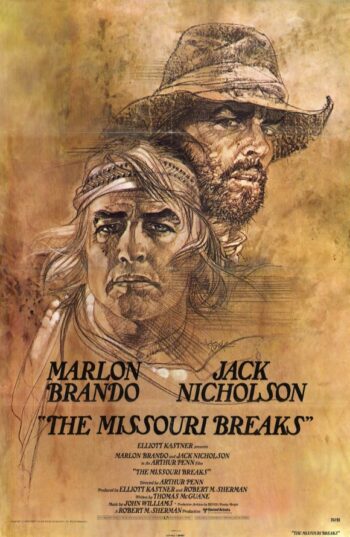
05.19.76
THE MISSOURI BREAKS
A rancher, a rustler, and a regulator face off in Arthur Penn’s eccentric western. As a cover for their horse thievery, a gang of Montana rustlers, led by the laid-back Tom Logan (Jack Nicholson), buys a small farm adjacent to the ranch of their latest target/nemesis, Braxton (John McLiam). When the gang leaves Tom on the farm and heads to Canada for another score, Tom takes a shine both to farming and Braxton’s rebellious, strong-willed daughter, Jane (Kathleen Lloyd). The slightly loco Braxton, however, hires the psychopathic regulator Lee Clayton (Marlon Brando) to root out the rustlers. With a series of unorthodox methods (and costumes), Clayton hunts down Logan and his gang one by one, even after Braxton fires him, but Logan isn’t about to let Clayton (or Braxton) make him obsolete. ~ Lucia Bozzola, Rovi
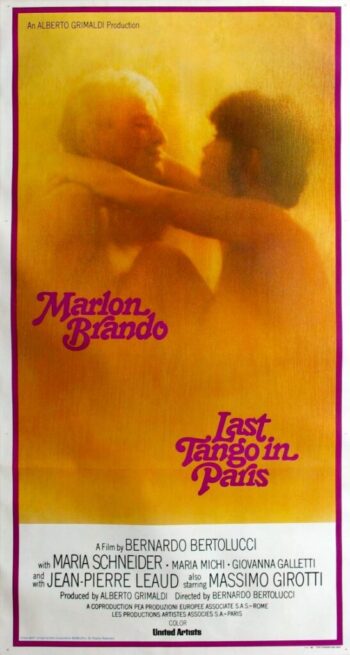
01.27.73
LAST TANGO IN PARIS
In Bernardo Bertolucci’s art-house classic, Marlon Brando delivers one of his characteristically idiosyncratic performances as Paul, a middle-aged American in “emotional exile” who comes to Paris when his estranged wife commits suicide. Chancing to meet young Frenchwoman Jeanne (Maria Schneider), Paul enters into a sadomasochistic, carnal relationship with her, indirectly attacking the hypocrisy all around him through his raw, outrageous sexual behavior. Paul also hopes to purge himself of his own feelings of guilt, brilliantly (and profanely) articulated in a largely ad-libbed monologue at his wife’s coffin. If the sexual content in Last Tango is uncomfortably explicit (once seen, the infamous “butter scene” is never forgotten), the combination of Brando’s acting, Bertolucci’s direction, Vittorio Storaro’s cinematography, and Gato Barbieri’s music is unbeatable, creating one of the classic European art movies of the 1970s, albeit one that is not for all viewers. ~ Hal Erickson, Rovi
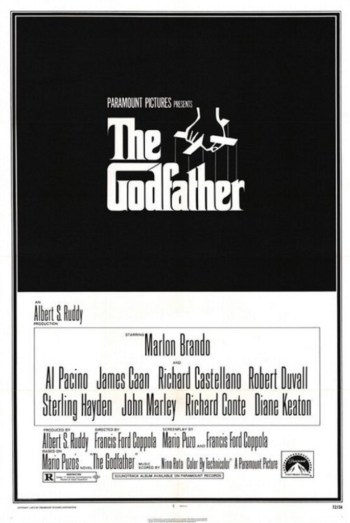
03.15.72
THE GODFATHER
Popularly viewed as one of the best American films ever made, the multi-generational crime saga The Godfather is a touchstone of cinema: one of the most widely imitated, quoted, and lampooned movies of all time. Marlon Brando and Al Pacino star as Vito Corleone and his youngest son, Michael, respectively. It is the late 1940s in New York and Corleone is, in the parlance of organized crime, a “godfather” or “don,” the head of a Mafia family. Michael, a free thinker who defied his father by enlisting in the Marines to fight in World War II, has returned a captain and a war hero. Having long ago rejected the family business, Michael shows up at the wedding of his sister, Connie (Talia Shire), with his non-Italian girlfriend, Kay (Diane Keaton), who learns for the first time about the family “business.” A few months later at Christmas time, the don barely survives being shot by gunmen in the employ of a drug-trafficking rival whose request for aid from the Corleones’ political connections was rejected. After saving his father from a second assassination attempt, Michael persuades his hotheaded eldest brother, Sonny (James Caan), and family advisors Tom Hagen (Robert Duvall) and Sal Tessio (Abe Vigoda) that he should be the one to exact revenge on the men responsible. After murdering a corrupt police captain and the drug trafficker, Michael hides out in Sicily while a gang war erupts at home. Falling in love with a local girl, Michael marries her, but she is later slain by Corleone enemies in an attempt on Michael’s life. Sonny is also butchered, having been betrayed by Connie’s husband. As Michael returns home and convinces Kay to marry him, his father recovers and makes peace with his rivals, realizing that another powerful don was pulling the strings behind the narcotics endeavor that began the gang warfare. Once Michael has been groomed as the new don, he leads the family to a new era of prosperity, then launches a campaign of murderous revenge against those who once tried to wipe out the Corleones, consolidating his family’s power and completing his own moral downfall. Nominated for 11 Academy Awards and winning for Best Picture, Best Actor (Marlon Brando), and Best Adapted Screenplay, The Godfather was followed by a pair of sequels. ~ Karl Williams, Rovi
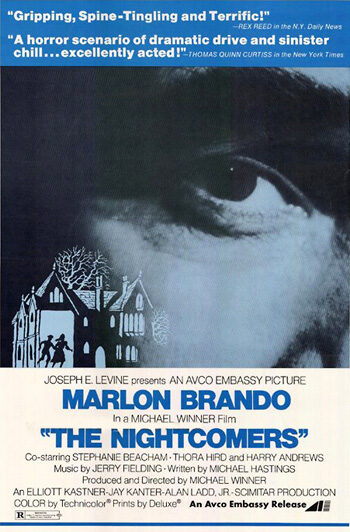
02.15.72
THE NIGHTCOMERS
Marlon Brando delivers a respectably creepy performance in the Michael Winner directed The Nightcomers — a film inspired by the characters in Henry James’ The Turn of the Screw. On a British country estate, two recently-orphaned children, Miles (Christopher Ellis) and Flora (Verna Harvey), live on their own with only a nurse, housekeeper, and gardener as companions. Miles and Flora are particularly fascinated by the gardener, Quint (Marlon Brando). In fact, fascinated to the point of obsession, the boy and girl model their young lives after him. When Quint becomes involved with the prim and proper nurse, Miles surreptitiously views their love-making and keeps it in mind for future reference. Gradually, Miles and Flora adopt the gardener and the nurse’s love-hate relationship for their own, copying their adult behavior with child-like abandon. Finally, when the housekeeper finds out and decides to fire the gardener and the nurse, the children are thrown into a panic. Not wanting their two favorite subjects to be separated, the children decide to take things into their own hands. ~ Paul Brenner, Rovi
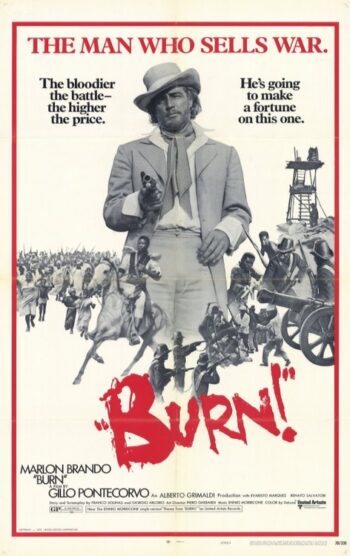
10.21.70
BURN! (AKA QUEIMADA)
Sir William Walker (Marlon Brando) is the aristocratic secret agent sent by Britain to secure a profitable Portuguese sugar cane plantation for the Crown. When he arrives, he befriends the black dockworker Jose (Evaristo Marquez) and plants revolutionary ideas in his head. Walker talks Jose into robbing a bank and builds him up as a national hero in the process. Teddy Sanchez (Renato Salvatori) is the hotel desk clerk with political aspirations who falls under Walker’s spell. The blacks revolt on the night of a festival parade that allows them to be disguised and move around without suspicion. Jose turns his troops over to Teddy, who assumes control of the island. Walker returns to Britain but is summoned ten years later to stop a revolution led by Jose against the now corrupt government headed by Teddy. British troops attack the island and hundreds are killed including Teddy who is executed for treason. The sugar cane crops perish in flames when Jose mounts an attack against the British. When William offers him freedom, Jose refuses by stating “freedom is something you take for yourself.” Jose is assassinated and becomes yet another martyr for the cause against colonialism. A drunk and despondent William prepares to leave the island realizing he is just as much a pawn as the men he initially incited to revolt. ~ Dan Pavlides, Rovi
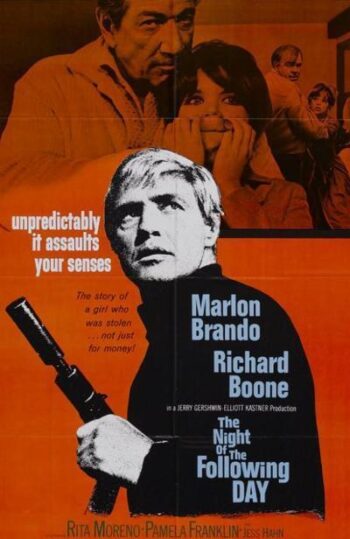
02.19.69
THE NIGHT OF THE FOLLOWING DAY
A pair of desperate men plan to kidnap a wealthy heiress upon her arrival in France. Bud (Marlon Brando) and Leer (Richard Boone) grab the gorgeous girl (Pamela Franklin) at the airport in Paris. The limousine is driven down a deserted country road where the airplane’s stewardess Vi (Rita Moreno) is in on the plan and helps the criminals switch cars. The quartet heads to a remote beach house where the girl’s father is contacted with instructions for the payoff. When the girl tries to escape, Bud helps her from being roughed up by Leer, which makes the heroine junkie Vi jealous. Vi’s brother Wally (Jess Hahn) goes with to the saloon where the drop-off is scheduled, but Wally is wounded in a gun battle with the bartender. He escapes and gives the money to Leer, who is finished having his sadistic carnal way with the kidnap victim. Bud once again tries to help the girl, and Leer tries to shoot everyone who stands in his way. The feature ends with a hard-to-fathom surprise in this violent story of murder, greed and love of money. ~ Dan Pavlides, Rovi

12.16.68
CANDY
In this big-budget adaptation of Terry Southern’s satiric sex farce (the sort of project that could get an immediate green light in the late 1960′s and at practically no other time before or since), Ewa Aulin is Candy, a sweet young woman who doesn’t seem entirely aware of the powerful sexual desire she brings out in men. While her father (John Astin) and mother (Elsa Martinelli) try to keep Candy in line, the task proves to be all but impossible, as she’s seduced by a remarkable variety of men in her journeys, including a booze-addled poet (Richard Burton), a mystical guru who lives on a truck (Marlon Brando), a gardener from Mexico (Ringo Starr), a fanatical military man who refuses to leave his plane (Walter Matthau), a pair of uncomfortably high-strung doctors (John Huston and James Coburn) and even her own uncle (Astin, again). The Byrds and Steppenwolf contributed songs to the soundtrack; the screenplay was written by Buck Henry. ~ Mark Deming, Rovi
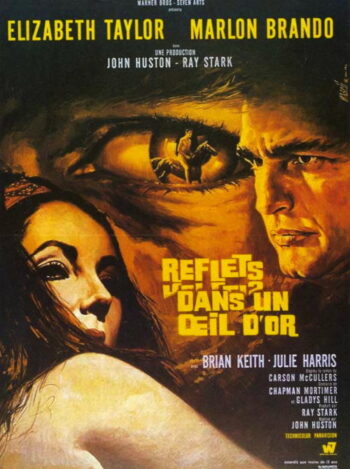
10.11.67
REFLECTIONS IN A GOLDEN EYE
This dreary story of the latent desires of the sexually repressed and psychologically tormented is taken from the 1944 novel by Carson McCullers. Major Penderton (Marlon Brando) is a hard-driving Army officer married to Leonora (Elizabeth Taylor). The impotent Penderton hides his latent homosexuality under his strict military discipline, while Leonora is having an affair with Lt. Colonel Langdon (Brian Keith), who is married to the troubled Allison (Julie Harris), who slices off her own nipples after a disappointing pregnancy. Private Williams (Robert Forster) is a young recruit who likes to ride naked on horseback. The Major is driven to insane jealousy when he discovers Williams would rather be with Leonora than with him. The idea is good, but the story plays like a sort of discarded (Tennessee Williams) play. ~ Dan Pavlides, Rovi
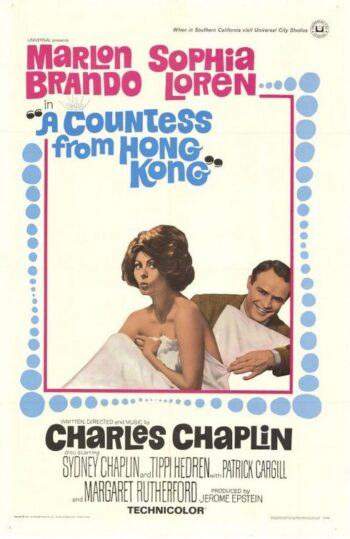
05.19.76
A COUNTESS FROM HONG KONG
Charles Chaplin wrote, directed, and scored this old-fashioned romantic comedy, which proved to be his last film. Wealthy American diplomat Ogden Mears (Marlon Brando) is sailing from Hong Kong to Hawaii, where he hopes to meet and reconcile with his estranged wife Martha (Tippi Hedren). However, while the ship takes on passengers in Hong Kong, a stowaway slips into Mears’ suite. Natascha (Sophia Loren) is a White Russian countess who was forced to flee the country following the revolution and ended up in Hong Kong, where she earns a meager living as a dime-a-dance girl in a sleazy ballroom. When Mears discovers that Natascha is an uninvited guest in his quarters, she begs him to help her emigrate to the United States; when he refuses, Natascha tries a new tack, threatening to tell Martha that they’ve been sharing a stateroom if he doesn’t cooperate. Mears grudgingly allows Natascha to stay with him and keep her secret until he can figure out a clever way to get rid of her. Margaret Rutherford has a showy supporting role as an eccentric passenger, and Chaplin gives himself a silent cameo as a bumbling porter (no fewer than four of his children also appear). ~ Mark Deming, Rovi

09.14.66
THE APPALOOSA
Buffalo hunter Matt Fletcher enters a church in the border town of Ojo Prieto. He plans to begin a new life by using his magnificent Appaloosa stallion to start a horsebreeding farm with his old friend Paco, an impoverished Mexican farmer. His hopes are ruined, however, when Trini, a young woman who has been sold by her parents to Mexican bandit Chuy Medina, tells Chuy that Matt molested her in church. When Chuy enters the church, Trini escapes on Matt’s Appaloosa, but she is quickly captured and returned by Chuy’s pistoleros. Matt’s hopes are shattered when Chuy steals the horse and drags Matt by a rope through a rock-strewn brook. After recovering from his injuries, Matt ventures into Chuy’s stronghold and confronts him in a hand-wrestling match in which poisonous scorpions await the one whose arm is forced to the table. Matt loses but saves his life by cutting open the wound with a piece of broken glass. Trini comes to his aid and hides him in a shack owned by Ramos, a goatherd, and nurses him back to health. Squint-Eye, another of Chuy’s pistoleros, comes to the shack looking for Matt and Trini, and when Ramos refuses to divulge their whereabouts, Squint-Eye kills Ramos. After killing Squint-Eye, Matt then returns to Chuy’s stronghold, retrieves the Appaloosa, and flees toward the border with Trini. Chuy follows, and Matt, realizing that Trini means more to him than the horse, sends out the Appaloosa to draw Chuy’s fire. As the bandit aims for the horse, Matt fires and kills him. Matt and Trini then cross the border with the Appaloosa to start a new life. ~ AFI
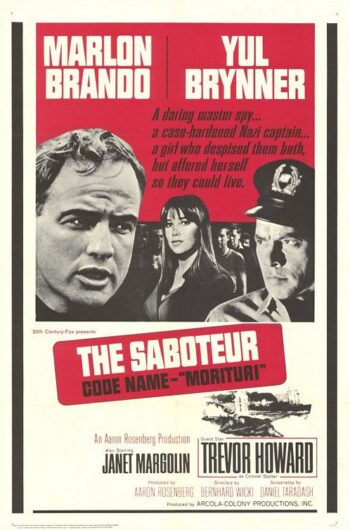
08.25.65
MORITURI
Bernhard Wicki directed this hard-hitting World War II espionage drama. Marlon Brando plays Robert Crain, a German deserter who is coerced by British Intelligence officer Colonel Statter (Trevor Howard) to impersonate a Gestapo officer in order to get aboard a German blockade runner that is conveying a valuable rubber cargo from the Orient. Crain’s assignment is to save the rubber by finding a way to deactivate the explosives that the ship’s captain would use to destroy the ship if captured by the enemy. Crain finds his way aboard the ship, but the ship’s commander Captain Mueller (Yul Brynner), skeptical of the Nazis, refuses to let Crain out of his sight. When survivors of a sunken vessel board the ship, and Crain realizes that his identity may be exposed by two rescued German submarine officers, he incites Mueller’s officers and the new arrivals to mutiny before his true identity is revealed. ~ Paul Brenner, Rovi

06.10.64
BEDTIME STORY
An exercise in “black humor” bordering on the tasteless, Bedtime Story stars Marlon Brando and David Niven as a pair of womanizing confidence tricksters, operating up and down the Riviera. Pooling their talents, Brando and Niven pull off several scams, many of these requiring Brando to pose as a mental or physical defective. Their current “mark” is soap heiress Shirley Jones, who isn’t quite as gullible as she seems. The film’s highlights-or low points, depending on one’s point of view-feature Brando pretending to be a mentally challenged man with a Napoleon complex, and a paraplegic who is “cured” by Jones’ love (remember that this is the same actor who so sensitively portrayed a genuine paraplegic in The Men). Created by the same folks who brought you such TV favorites as Green Acres and Beverly Hillbillies, Bedtime Story was remade in 1988 as Dirty Rotten Scoundrels, with Steve Martin, Michael Caine, and Glenne Headley in the roles originally filled by Brando, Niven and Jones. ~ Hal Erickson, Rovi

04.02.63
the ugly american
Taken from a best-selling book, this is an uneven, politically tinged drama by George Englund that does not really follow the book that closely. Marlon Brando is Harrison Carter MacWhite, an ambassador to a Southeast Asian country that goes unnamed but stands in well for Vietnam. There is a growing movement against Yankee imperialism and the current government, increasing unrest, and other signs of a complex situation getting worse. At first the ambassador relies on past training and has his own facile explanations for the unfolding events. But as time goes by, he comes to learn that a revolutionary movement is not one-dimensional. Unfortunately, the film itself never adequately clarifies the events it depicts. ~ Eleanor Mannikka, Rovi
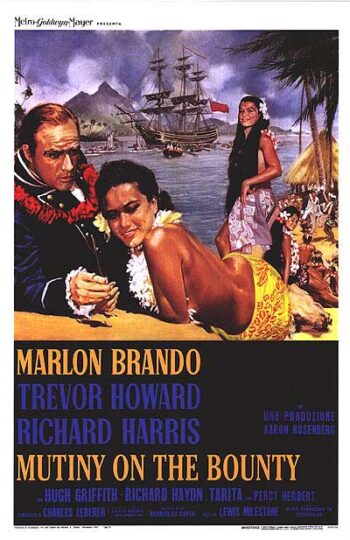
11.08.62
MUTINY ON THE BOUNTY
This colorful remake of the 1935 version again concerns the crew and treatment of the HMS Bounty by a cold hearted sadistic captain. Captain Bligh (Trevor Howard) boards the ship in Portsmouth, England, to embark on a mission to bring tropical breadfruit trees to Jamaica. Fletcher Christian (Marlon Brando) is the aristocratic second mate who welcomes the new captain aboard. Christian’s view of the captain sours with the cruel treatment of the crew and the dangerous decision to round Cape Horn.The Bounty sails into the teeth of a ferocious winter storm which is another in a long line of indignities suffered on the journey. John Mills (Richard Harris) is punished for stealing cheese. A sailor is ordered to stay aloft in the crow’s nest, nearly resulting in death. The crew finds temporary paradise in Tahiti before Bligh’s behavior becomes intolerable for the once faithful Christian. The crew revolts and sends the captain on his way in a small rowboat. Settling on Pitcairn Island, the crew soon realizes they may never see England again. Mills burns the ship to insure the trip is never made. Christian attempts to save the only means of transportation of their new island home. Lewis Milestone directed the film which was plagued by constant cost overruns to the tune of 18 million dollars. Brando’s legendary ego clashed with results as turbulent as the fictitious trip around stormy Cape Horn. The movie retained slightly over half the cost of the production price tag in its initial release. ~ Dan Pavlides, Rovi
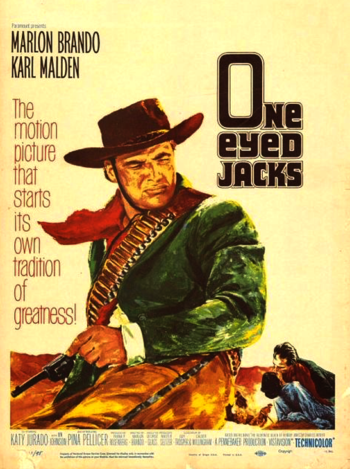
03.30.61
one-eyed jacks
Western bandit Kid Rio (Marlon Brando) is betrayed by his partner, Dad Longworth (Karl Malden). Escaping from prison, Rio learns that Longworth has become a wealthy and influential lawman. Rio thirsts for revenge, but bides his time, waiting for the right moment to strike. In the meantime, Rio spitefully seduces Longworth’s adopted daughter, Louisa (Pina Pellicer). After killing a man in self-defense, Rio is publicly whipped by the powerful Longworth. When Rio’s old gang accidentally kills a child during another holdup, Longworth has the perfect excuse to eliminate the troublesome Rio once and for all by hanging him. But that’s not what happens at all. Stripped to its fundamentals, One-Eyed Jacks is a workable Western, worthy of perhaps 90 minutes’ running time. But when Marlon Brando succeeded Stanley Kubrick in the director’s chair, he allowed the film’s 60-day shooting schedule to stretch into six months, and delivered a finished product running in excess of four hours. The current 141-minute version of One-Eyed Jacks isn’t as ponderous as some critics have claimed, but it’s still too much of a good thing. While Brando the director isn’t precisely in the Kubrick class, Brando the actor delivers one of his finest and most focused performances (though he is upstaged throughout by Karl Malden). ~ Hal Erickson, Rovi
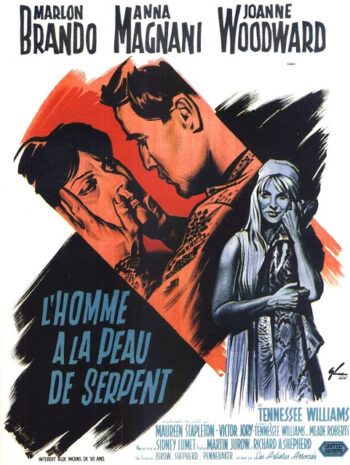
04.14.60
the fugitive kind
Fugitive Kind began life as Battle of Angels, a never-produced 1939 play by a young Tennessee Williams. Nearly 20 years later, Williams refined this rough-hewn theatrical effort into Orpheus Descending, which enjoyed a respectable Broadway run. The renamed film version stars Marlon Brando as Valentine “Snakeskin” Xavier, a trouble-prone drifter who wanders into a deliciously Williamsesque Mississippi town. Here he becomes involved in the problems of alcoholic Carole Cutrere (Joanne Woodward) and unhappily married Lady Torrence (Anna Magnani) and also runs afoul of Torrence’s vicious husband (Victor Jory). Sexual symbolism abounds in this tempestuous drama, which offers Brando at his most inscrutable and Magnani at her earthiest. Maureen Stapleton, in real life one of Brando’s best friends and severest critics, plays an avant-garde artist. ~ Hal Erickson, Rovi

04.02.58
the YOUNG LIONS
Though several concessions to the censors and the box-office were made in adapting Irwin Shaw’s bestseller The Young Lions to the screen, the end result is generally effective and satisfying. Set during World War II, the film concentrates on three individuals, one German, two American. Marlon Brando plays an idealistic German whose early fascination with Nazism leads to doubt and disillusionment. American entertainer Dean Martin, on the verge of the Big Time, does his best to dodge the draft but ends up in uniform all the same. And American Jew Montgomery Clift, so sensitive that he’s practically breakable, must come to grips with anti-Semitism, not only from the Germans but also from his fellow soldiers. Romance enters the picture in the form of Hope Lange as Clift’s gentile girlfriend, Barbara Rush as the socialite who shames Martin into joining up, and May Britt as Brando’s vis-a-vis. Screenwriter Edward Anhalt was obliged to shoehorn in a boot-camp sequence indicating that the Brass disapproved of the bigoted behavior of Clift’s topkick Lee van Cleef (as if racism was a mere aberration during the 1940s), and to “slightly” alter the ending of the book, in which the embittered but still patriotic Brando character, shouting “Welcome to Germany!,” machine-guns the Martin and Clift characters (in the film, it is Brando who bites the dust, symbolically dying for Hitler’s sins). Maximillian Schell offers a starmaking turn as Brando’s cynical comrade, while an uncredited John Banner, “Sergeant Schultz” on Hogan’s Heroes, shows up as a pompous burgomeister who feigns ignorance of the hellish concentration camp in his community. ~ Hal Erickson, Rovi
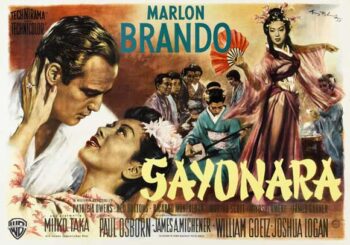
12.05.57
SAYONARA
Sayonara takes its own sweet time to unfold; in so doing, it permits us to make intimate acquaintance with its characters, so as to better understand their multi-textured motivations. The film is set in Japan during the Korean War. While on leave, pugnacious American soldier Joe Kelly (Red Buttons) falls in love with Japanese maiden Katsumi (Miyoshi Umeki). Given the army’s official policy against interracial marriage, Kelly is courting a court-martial. His best friend, Major Lloyd “Ace” Gruver (Marlon Brando), tries to talk Kelly out of “ruining” his life. Gruver himself is about to marry Eileen Webster (Patricia Owens), the daughter of General Webster (Kent Smith). Fighting back his own prejudices, Gruver agrees to be Kelly’s best man at the latter’s wedding to Katsumi. Later, Gruver himself falls for Hana-Ogi (Miiko Taka), a beautiful lead dancer of the famed Matsubayashi Girls Revue. This sparks an all-out onslaught of racial bigotry from the Army brass, and an official edict sending American soldiers back to the states without their Japanese wives. Kelly cannot bear being parted with Katsumi; as a result, the two commit suicide. The tragedy compels the army to soften its attitudes towards miscegenation. Gruver is reunited with Hana-Ogi, who in a parallel situation has had to ward off the inbred prejudices of her people. Nominated for ten Academy Awards, Sayonara won five, including “Best Supporting Actor” (Red Buttons, whose moribund career was revitalized herein) and “Best Supporting Actress” (Miyoshi Umeki). And yes, that is Ricardo Montalban in Japanese makeup as a Kabuki actor. ~ Hal Erickson, Rovi

11.29.56
THE TEAHOUSE OF THE AUGUST MOON
Marlon Brando went out on yet another creative limb when he insisted upon playing sly, philosophical Okinawan interpreter Sakima in the 1956 filmization of John Patrick’s Broadway play Teahouse of the August Moon. While he occasionally lapses into “flied lice” stereotyping, for the most part Brando is quite effective and amusing, especially when facing up to the difficult task of speaking directly to the audience. The story is set in Okinawa in the months following V-J Day. Paul Ford (repeating his Broadway role – and replacing Louis Calhern, who died at the start of production) plays an American colonel in charge of the occupation troops. Determined to bring Western civilization to the Okinawans, the colonel assigns captain Glenn Ford to do his bidding. A habitual screw-up, Captain Ford hopes to make good by organizing the Okinawan women into a social club and by building a schoolhouse. But the villagers would rather erect a teahouse, serviced by pretty geisha girls. The ever-resourceful Sakima (Brando) does his manipulative best to curry favor with the Americans while still mollifying his own people. Co-starring in Teahouse of the August Moon is Machiko Kyo, leading lady of such Japanese film classics as Rashomon and Gate of Hell. ~ Hal Erickson, Rovi
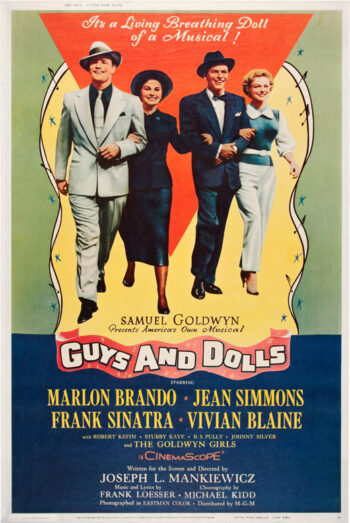
11.03.55
GUYS AND DOLLS
This 1955 film began life as two Runyon short stories, the most prominent of which was “The Idyll of Miss Sarah Brown.” This material was fleshed out into a 2-act libretto by Abe Burrows and Jo Swerling, then set to music by Frank Loesser and directed by George S. Kaufman. Opening late in 1950, Guys and Dolls was one of Broadway’s hottest tickets for several seasons. The plot involves a certain Broadway citizen by the name of Nathan Detroit (Frank Sinatra), who maintains the “Oldest EstablishedPermanent Floating Crap Game in New York.” Seeking a location for his latest high-stakes game, Nathan has an opportunity to rent out the Biltmore Garage, but he needs $1000 to do so. He decides to extract the money from high-rolling Sky Masterson (Marlon Brando), known for his willingness to bet on anything. Nathan wagers that Sky will not be able to talk the virginal Salvation Army lass Sarah Brown (Jean Simmons) into going on a date with him. While Sky goes to work on Sarah, Nathan endeavors to fend off his girlfriend Miss Adelaide (Vivian Blaine, repeating her Broadway role), who has developed a psychosomatic cold because of her frustrating 14-year engagement to the slippery Mr. Detroit. Thanks to some fast finagling, Sky is able to take Sarah on that date, flying to Havana for this purpose. By the time they’ve returned to New York, Sky and Sarah are in love, but their ardor cools off abruptly when Nathan, unable to secure the Biltmore garage, attempts to use Sarah’s mission as the site of his crap game. ~ Hal Erickson, Rovi
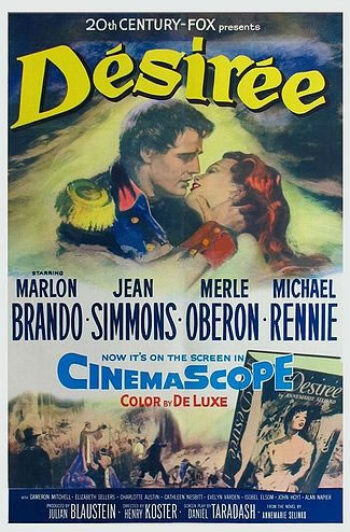
11.16.54
DÉSIRÉE
Director Henry Koster and writer Daniel Taradash speculate mightily in this historical tableau charting the rise and fall of Napoleon (Marlon Brando), all due to his unrequited love for noblewoman Desiree (Jean Simmons). The film takes a chronological view of Napoleon’s reign and posits Napoleon’s love of a woman he wanted to marry as a young general but abandoned for the sake of his career. Both Napoleon and Desiree go their separate ways — he to become Emperor of France and loveless husband to Josephine (Merle Oberon) and she to become Sweden’s disinterested Queen. Napoleon and Desiree meet up again in a whimsical confrontation in which Desiree urges the Little Corporal to surrender and go to St. Helena. The film is based on a novel by Annemarie Selinko that, like the film, takes wild liberties with the truth. ~ Paul Brenner, Rovi

07.28.54
ON THE WATERFRONT
This classic story of Mob informers was based on a number of true stories and filmed on location in and around the docks of New York and New Jersey. Mob-connected union boss Johnny Friendly (Lee J. Cobb) rules the waterfront with an iron fist. The police know that he’s been responsible for a number of murders, but witnesses play deaf and dumb (“plead D & D”). Washed-up boxer Terry Malloy (Marlon Brando) has had an errand-boy job because of the influence of his brother Charley, a crooked unionlawyer (Rod Steiger). Witnessing one of Friendly’s rub-outs, Terry is willing to keep his mouth shut until he meets the dead dockworker’s sister, Edie (Eva Marie Saint). “Waterfront priest” Father Barry (Karl Malden) tells Terry that Edie’s brother was killed because he was going to testify against boss Friendly before the crime commission. Because he could have intervened, but didn’t, Terry feels somewhat responsible for the death. When Father Barry receives a beating from Friendly’s goons, Terry is persuaded to cooperate with the commission. Featuring Brando’s famous “I coulda been a contendah” speech, On the Waterfront has often been seen as an allegory of “naming names” against suspected Communists during the anti-Communist investigations of the 1950s. Director Elia Kazan famously informed on suspected Communists before a government committee — unlike many of his colleagues, some of whom went to prison for refusing to “name names” and many more of whom were blacklisted from working in the film industry for many years to come — and Budd Schulberg’s screenplay has often been read as an elaborate defense of the informer’s position. On the Waterfront won Oscars for Best Picture, Best Director, Best Adapted Screenplay, Best Actor for Brando, and Best Supporting Actress for Saint. ~ Hal Erickson, Rovi
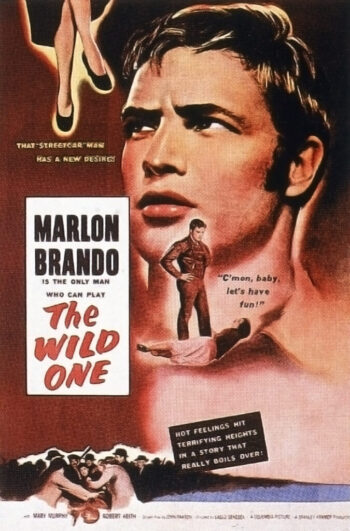
12.30.53
THE WILD ONE
“What are you rebelling against?” asks someone. “What’ve you got?” responds surly, leather-jacketed motorcycle punk Marlon Brando. It comes as a disappointment to discover that The Wild One, the quintessential Brando “rebel” film, is at base a traditional “misunderstood youth vs. the nasty system” effort, with a particularly banal finale. Based on a true incident, the film begins with Brando and his motorcyle gang invading a small town after having been kicked out of a cycle competition (but notbefore stealing the second-prize trophy). Brando’s bikers raise hell all day, but some of the townsfolk are shown to be little better than the invaders. Sheriff Robert Keith, whose daughter (Murphy) has gone fond of Brando, finally responds to the bikers’ destructiveness by jailing Lee Marvin, leader of a rival gang. When Marvin’s buddies goes on a rampage, Brando exhibits his essential decency by safely escorting the sheriff’s daughter out of the melee. The townsfolk misunderstand, assuming that Brando intends to rape the girl. He is attacked by a vigilante mob led by town hothead Ray Teal, who uses this excuse to exercise his own sadistic tendencies. Keith breaks up the mob and suggests that Brando leave; he tries to do so, but another angry response from the mob causes him to inadvertently strike and kill a pedestrian. At the subsequent hearing, the girl rushes to Brando’s defense. Though grateful for the unexpected kindness, Brando is constitutionally unable to say “thank you” and rides out of town alone. The image of Marlon Brando astride his Triumph has entered movie folklore, just like King Kong on the Empire State Building or the billow-skirted Marilyn Monroe standing over a subway grating; it’s too bad that The Wild One isn’t a more worthy vehicle for Brando’s talents. ~ Hal Erickson, Rovi
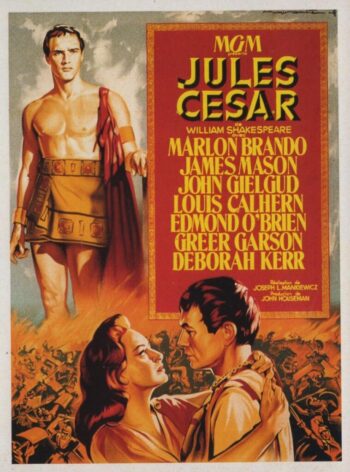
06.03.53
JULIUS CAESAR
Joseph L. Mankiewicz directed this exquisite version of William Shakespeare’s play. Louis Calhern is Julius Caesar, whose conquests have enabled him to rise to the status of Roman dictator. But his ascent to almost God-like status has given pause to influential members of the Roman Senate. Chief among them is Cassius (John Gielgud), who is troubled by Caesar’s popularity and dictatorial status. Convinced that Caesar’s assassination would be the best thing for Rome, he conspires with Casca (Edmond O’Brien) and the influential Brutus (James Mason) to plot Caesar’s murder. Despite dark omens, Caesar walks confidently into the Roman Senate, where he is stabbed to death by the conspirators. His companion Marc Antony (Marlon Brando) is shocked and runs to the corpse of his beloved friend. He agrees to support Brutus while an unruly mob gathers in front of the Senate doors, having heard rumors of Caesar’s assassination. Brutus convinces the mob that Caesar’s death was for the good of Rome, preventing him from forming a monarchy. Then Antony appears, determined to destroy the conspirators; he delivers a speech that subtly damns the assassins. With the mob against them, the conspirators are forced to flee Rome and Antony organizes an army against them. ~ Paul Brenner, Rovi
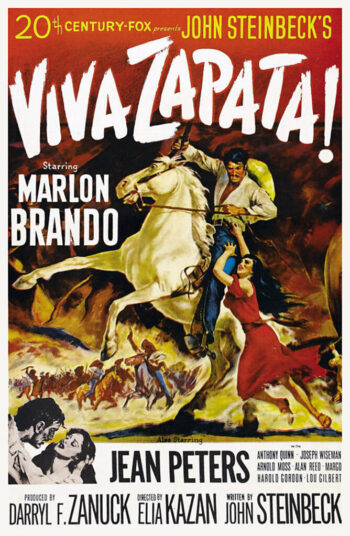
02.07.52
VIVA ZAPATA!
Produced by Darryl F. Zanuck and directed by Elia Kazan, this film follows the life of Mexican revolutionary leader Emiliano Zapata (Marlon Brando) from his peasant upbringing, through his rise to power in the early 1900s, to his death. The film presents an interesting but fictionalized picture of Zapata. Zapata, the child of tenant-farmers, was joined by Pancho Villa in his rebellion against tyrannical President Porfirio Diaz. The film romanticizes Zapata and in doing so unfortunately distorts the true nature of the wars he waged. Zapata fought, not to conquer Mexico but to free the land for the peasants of Morelos and other southern provinces. The Oscar-nominated screenplay by John Steinbeck ignores some historical details in order to focus on the corruptive influence of power. Marlon Brando won an Academy Award nomination for his work, as did Anthony Quinn, who took home the Best Supporting Actor Oscar for his headstrong, hard-fighting, hard-drinking, intensely romantic character who does not hesitate to die for love. The film also features a beautiful score by Alex North, who also received an Academy Award nomination. ~ Linda Rasmussen, Rovi
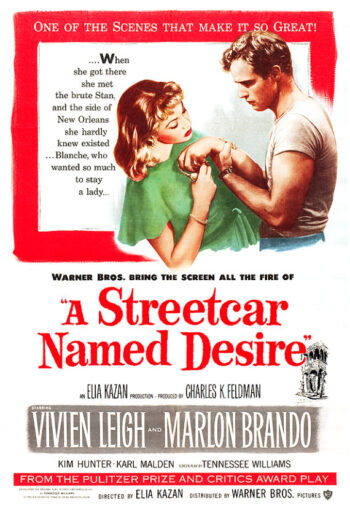
04.18.51
A STREETCAR NAMED DESIRE
In the classic play by Tennessee Williams, brought to the screen by Elia Kazan, faded Southern belle Blanche DuBois (Vivien Leigh) comes to visit her pregnant sister, Stella (Kim Hunter), in a seedy section of New Orleans. Stella’s boorish husband, Stanley Kowalski (Marlon Brando), not only regards Blanche’s aristocratic affectations as a royal pain but also thinks she’s holding out on inheritance money that rightfully belongs to Stella. On the fringes of sanity, Blanche is trying to forget her checkered past and start life anew. Attracted to Stanley’s friend Mitch (Karl Malden), she glosses over the less savory incidents in her past, but she soon discovers that she cannot outrun that past, and the stage is set for her final, brutal confrontation with her brother-in-law. Brando, Hunter, and Malden had all starred in the original Broadway version of Streetcar, although the original Blanche had been Jessica Tandy. Brando lost out to Humphrey Bogart for the 1951 Best Actor Oscar, but Leigh, Hunter, and Malden all won Oscars. ~ Hal Erickson, Rovi
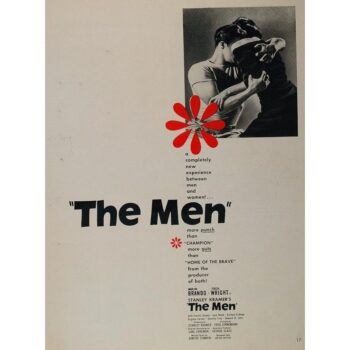
07.20.50
THE MEN
Fred Zinnemann’s sensitive film on the plight of paraplegic WWII veterans features Marlon Brando in his superbly moving screen debut. He plays Lt. Bud Wilozek, one of a group of veterans recovering in the paraplegic ward of a hospital in his hometown. His former fiancée, Ellen (Theresa Wright), explains to his physician, Dr. Brock (Everett Sloane), her concern about his isolation and apparent depression since he has broken their engagment and refuses to see her. He counsels her to be patient, but when he decides to broach the issue with Bud, the embittered patient reacts angrily to the doctor’s intrusiveness, and continues to refuse to see Ellen. The doctor cajoles the withdrawn paraplegic into the life of the ward, where fellow patients Richard Erdman, Jack Webb, and Arthur Jurado begin to pull Bud out of his spiritual miasma. At length, his sense of hope starts to return, and after seeing Ellen for the first time in months, he begins to contemplate the possibility of marriage. Zinnemann and screenwriter Carl Foreman spent a month in a veteran’s hospital researching the film, and Brando lived in the paraplegic unit for a time as part of his preparation. ~ Michael Costello, Rovi